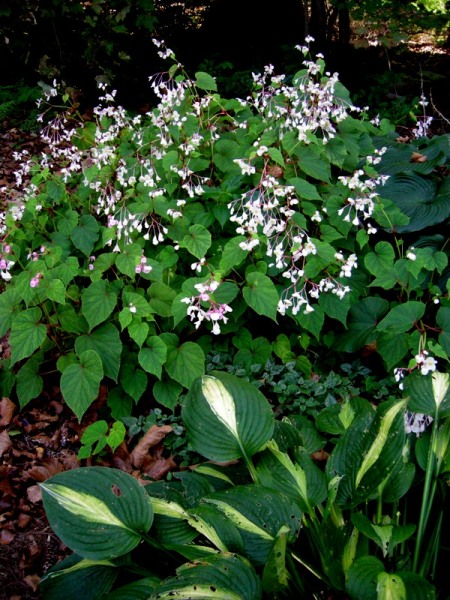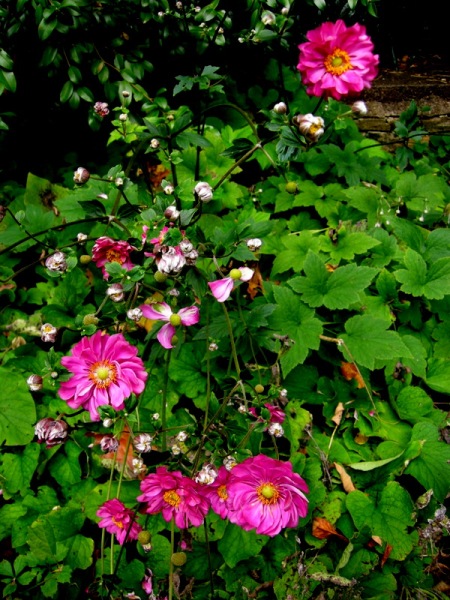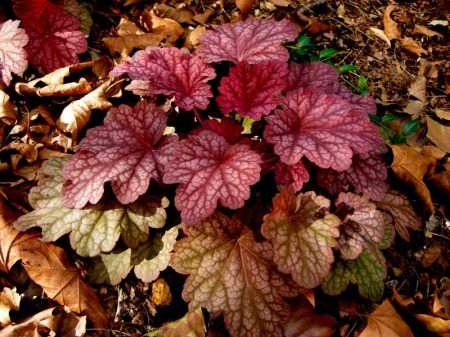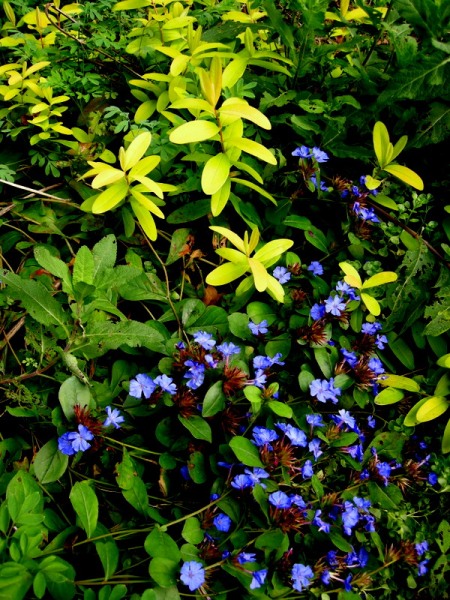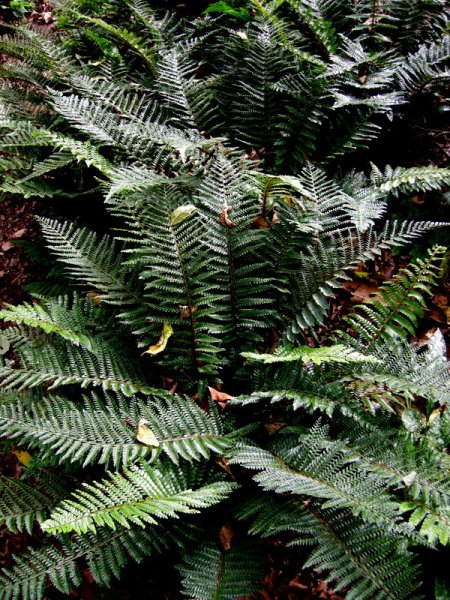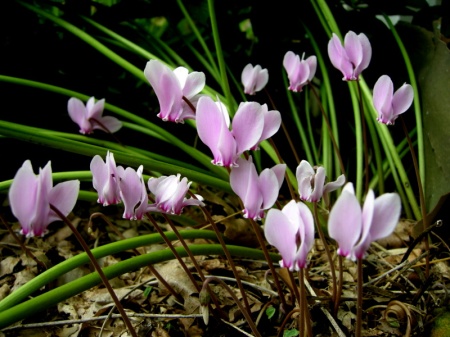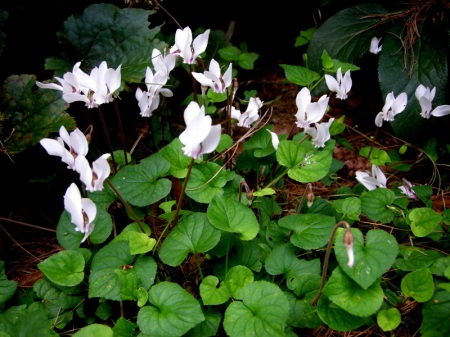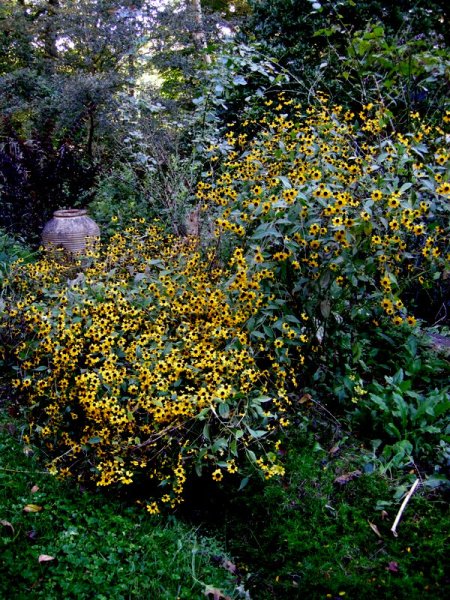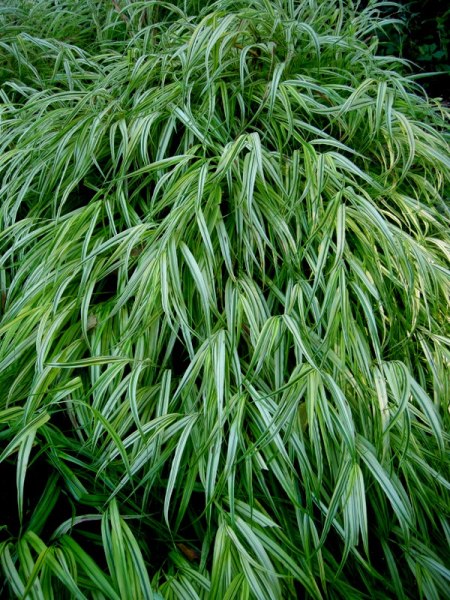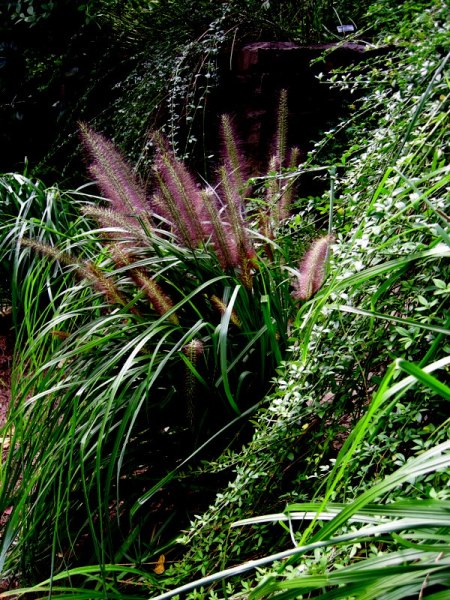Carolyn’s Shade Gardens is a retail nursery located in Bryn Mawr, PA, specializing in showy, colorful, and unusual plants for shade. The only plants that we ship are snowdrops and miniature hostas. For catalogues and announcements of events, please send your full name, location, and phone number (for back up use only) to carolyn@carolynsshadegardens.com. Click here to get to the home page of our website for catalogues and information about our nursery and to subscribe to our blog.
 US. native hart’s-tongue fern, Phyllitis scolopendrium, is especially beautiful in my garden in the spring as it unfurls, April 2010
US. native hart’s-tongue fern, Phyllitis scolopendrium, is especially beautiful in my garden in the spring as it unfurls, April 2010
Spring is in the wind here today with unseasonably warm temperatures of almost 70 degrees F (21 C). The ten day forecast shows more seasonable temperatures with highs in the mid-forties. Although spring is definitely on the way (it snowed and went down to 10 degrees since I wrote this!), the beauty of snow has been replaced with the grays and browns of late winter, not a look I treasure. That makes any plants that liven up the gardens very important at this time of year, and evergreen ferns do just that. Five of my favorites are profiled below.
 Hart’s-tongue fern is also very beautiful in the fall, mid-November 2010 with Christmas rose and pulmonaria
Hart’s-tongue fern is also very beautiful in the fall, mid-November 2010 with Christmas rose and pulmonaria
Hart’s-tongue fern, Phyllitis scolopendrium (zones 5 to 9), may be my favorite all time fern (today anyway). It has a very unique look that is absolutely magical when it unfurls in the spring (photo at top), and it maintains its good looks until it disappears under the snow (photo above). Even now it is quite presentable after our snowy and icy winter with only slight browning.
Although I call it a US native, hart’s tongue fern is actually indigenous to Europe, Asia, and North America, including the mid-Atlantic. However, according to John Mickel in Ferns for American Gardens, the US variety does poorly in cultivation, and all cultivated material is from the European variety. It is a clump-forming fern, growing 8 to 16″ tall with shiny, leathery fronds. It is easy to grow but suffers if over-watered and must be well-drained. I grow mine in part shade on a slope with plenty of organic matter. In the wild it is limestone-loving, but I haven’t found this to be necessary in my garden.
 Japanese holly fern, Cyrtomium falcatum, makes quite a statement in my mid-November garden
Japanese holly fern, Cyrtomium falcatum, makes quite a statement in my mid-November garden
Japanese holly fern, Cyrtomium falcatum (zones 6 to 10), is another favorite of mine. Individual plants grown as a specimen can be up to 2 feet tall and 3 feet across making quite a bold statement in the garden. It grows well in the deep shade of my woodland garden where there is more construction rubble than soil as well as on my partly shaded but very open back slope. Right now it is serving as a backdrop for the giant snowdrops, Galanthus elwesii, that are emerging between its fronds, which have been flattened by snow.
Japanese holly fern is native to Hawaii (do we call it a US native?), southern Africa, and across southern Asia. Although it is uncommon in the mid-Atlantic, it is quite commonly grown in the southern parts of the US and has naturalized in some areas. It is clump-forming with an elegant, vase-like habit and 4 to 7″ wide, glossy dark green fronds with toothed pinnae that resemble holly leaves. It prefers good drainage and organic soil in part to full shade.
 U.S. native deer fern, Blechnum spicant, also shines in my mid-November garden
U.S. native deer fern, Blechnum spicant, also shines in my mid-November garden
Deer fern, Blechnum spicant (zones 5 to 8), was new to my garden in spring of 2010 so, despite its moist native habitat, it survived this summer’s record-breaking heat and drought. The unusual texture provided by its linear segments is a great addition to the border in front of my fall-blooming camellias. It is in an eastern-facing location with high shade. Right now, though flattened by the snow and ice, the fronds look almost the same as in the photo above despite our hard winter.
Deer fern is native to moist coniferous forests in the US Pacific Northwest and Europe. Its two types of fronds are very distinct. The sterile fronds (pictured above) are 8 to 20″ long, evergreen, and prostrate, while the fountain-like fertile fronds, which emerge in the spring, are 16 to 24″ long, deciduous, and erect. It puts on quite a show in the spring. Deer fern grows in part to full shade in acid soil enriched with organic matter and spreads slowly by short creeping rhizomes.
 Tassel fern, Polystichum polyblepharum, growing in dry shade at the base of my Kentucky coffee tree in mid-November
Tassel fern, Polystichum polyblepharum, growing in dry shade at the base of my Kentucky coffee tree in mid-November
Tassel fern, Polystichum polyblepharum (zones 5 to 8), is a very trouble-free, evergreen fern that I have grown for years. I found that it does not do well in full shade, but thrives in high shade with dappled light. It is absolutely gorgeous in the spring, when the reddish, hairy new fronds unfurl (photo below) and still looks spectacular at the end of a hot dry summer (photo above). Right now it is flat to the ground exposing its fleecy stems even more.
 The bristly new fronds of tassel fern unfurl, photo courtesy of the Missouri Botanical Garden PlantFinder
The bristly new fronds of tassel fern unfurl, photo courtesy of the Missouri Botanical Garden PlantFinder
Tassel fern is native to Japan and southern Korea. According to Mickel, its species name means “many eyelashes” referring to its bristly, pubescent stems, which are really quite eye-catching even when fully emerged. Its lustrous dark green fronds form an elegant, vase-like crown 2 feet tall and 2 feet wide. It makes an excellent specimen. Grow it in part shade in a well-drained, humus-rich site.
 U.S. native Christmas fern, Polystichum acrostichoides, is ornamental 365 days a year in my garden, photo courtesy of the Missouri Botanical Garden PlantFinder
U.S. native Christmas fern, Polystichum acrostichoides, is ornamental 365 days a year in my garden, photo courtesy of the Missouri Botanical Garden PlantFinder
Christmas fern, Polystichum acrostichoides (zones 3 to 9), is without a doubt the best evergreen fern for mid-Atlantic US gardens. It grows well everywhere in my garden from my deeply shaded woodland to more sunny, rocky slopes. Right now, although not as upright as the photo above, it is the most presentable evergreen fern after our long, hard winter.
 Christmas fern growing an a rocky outcropping in Great Smoky Mountain National Park, Tennessee
Christmas fern growing an a rocky outcropping in Great Smoky Mountain National Park, Tennessee
Christmas fern is native to the whole eastern half of North America, including all of Pennsylvania. According to Mickel, its common name arose because it was used by early settlers as Christmas decorations. The lance-shaped, dark green, leathery fronds provide excellent winter interest. The two foot tall, fountain-like clumps increase in size over time, forming multiple crowns and making it easy to divide. Christmas fern is very easy to grow in part shade to full shade and in moist to dry soil and can be used on slopes to prevent erosion.
I hope I have convinced you to go outside and investigate where you can add some evergreen ferns for year round interest.
Please let me know in a comment/reply what evergreen ferns you grow in your garden.
Carolyn
Notes: John Mickel is Curator of Ferns for the New York Botanical Gardens. His book, Ferns for American Gardens, is an excellent resource discussing over 400 ferns with hundreds of photos. I have added it to my sidebar under Books so you can always find it.
Every word that appears in orange on my blog is a link that you can click for more information. If you want to return to my blog’s homepage to access the sidebar information (catalogues, previous articles, etc.), just click here.
Nursery Happenings: I am currently accepting orders for snowdrops, including mail orders. For the catalogue and order information, click here. I am taking reservations for my Hellebore Seminars for the Totally Obsessed. For the brochure and registration information, click here. I have three spaces left for the March 6 session of Charles Cresson’s Snowdrops and Other Winter Interest Plants Seminar. For the brochure and registration information, click here.
 I have recently been honored with the Stylish Blogger Award by six different blogs, and I want to thank them for the accolade. My friends would really laugh to hear the word stylish applied to me as a person, but I am glad I am making up for that with my blog. I am not following the award rules, but instead letting you know who gave me the award in hopes that you will visit their blogs. Here are the links and some information to entice you to visit them:
I have recently been honored with the Stylish Blogger Award by six different blogs, and I want to thank them for the accolade. My friends would really laugh to hear the word stylish applied to me as a person, but I am glad I am making up for that with my blog. I am not following the award rules, but instead letting you know who gave me the award in hopes that you will visit their blogs. Here are the links and some information to entice you to visit them:
Deb’s Garden: Deb shares her gardening experiences on 3.5 partially wooded acres in Helena, Alabama.
Island Threads: Frances battles the elements on the northern tip of an island off the northwest coast of Scotland.
Orchid de Dangau: Makirimi collects and grows orchids in Malaysia.
Southern Meadows: Karin writes about nature and gardening in northeastern Georgia.
Sweet Bean Gardening: Hanni is developing a cottage garden in Indiana with her two young daughters.
The Suburban Gardener: Lily specializes in lilies and hostas in her shady suburban Chicago, Illinois, garden.
 Native Virginia bluebells, Mertensia virginica, and native Celandine poppies, Stylophorum diphyllum, are two of my favorite plants for spring and are wonderful combined with almost anything. Very easy to grow in part to full shade and woodland conditions.
Native Virginia bluebells, Mertensia virginica, and native Celandine poppies, Stylophorum diphyllum, are two of my favorite plants for spring and are wonderful combined with almost anything. Very easy to grow in part to full shade and woodland conditions. Virginia bluebells with emerging tassel ferns, Polystichum polyblepharum.
Virginia bluebells with emerging tassel ferns, Polystichum polyblepharum. Or how about blue on blue with Virginia bluebells and Siberian bugloss, Brunnera macrophylla?
Or how about blue on blue with Virginia bluebells and Siberian bugloss, Brunnera macrophylla? Native Celandine poppies are just as versatile, here with summer snowflake, Leucojum aestivum.
Native Celandine poppies are just as versatile, here with summer snowflake, Leucojum aestivum. Native Celandine poppies with ‘Sulphureum’ epimedium, daffodils, native cinnamon fern, and the leaves of winter aconite, Eranthis hyemalis.
Native Celandine poppies with ‘Sulphureum’ epimedium, daffodils, native cinnamon fern, and the leaves of winter aconite, Eranthis hyemalis. Gold hostas look so beautiful when they are emerging. Here ‘Paradise Island’ hosta with ‘Bowles Purple’ vinca. Although I don’t recommend planting vinca because it is so invasive, I couldn’t resist adding this purple variety to a contained space.
Gold hostas look so beautiful when they are emerging. Here ‘Paradise Island’ hosta with ‘Bowles Purple’ vinca. Although I don’t recommend planting vinca because it is so invasive, I couldn’t resist adding this purple variety to a contained space. One of my all time favorite combinations, the peach-colored spring leaves of ‘Magic Carpet’ spiraea with the similarly colored stems of ‘Goldheart’ old-fashioned bleeding-heart.
One of my all time favorite combinations, the peach-colored spring leaves of ‘Magic Carpet’ spiraea with the similarly colored stems of ‘Goldheart’ old-fashioned bleeding-heart. Native ‘Purple Beauty’ moss phlox, P. subulata, with a sedum showing its winter colors.
Native ‘Purple Beauty’ moss phlox, P. subulata, with a sedum showing its winter colors. Checkered-lily in its white, Fritillaria meleagris ‘Alba’, and purple forms seed through out my dry, full shade woodland.
Checkered-lily in its white, Fritillaria meleagris ‘Alba’, and purple forms seed through out my dry, full shade woodland. Orange epimedium, E. x warleyense, with the emerging leaves of Hosta montana ‘Aureo-marginata’.
Orange epimedium, E. x warleyense, with the emerging leaves of Hosta montana ‘Aureo-marginata’.


